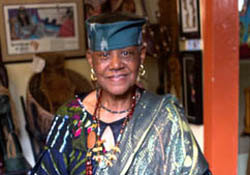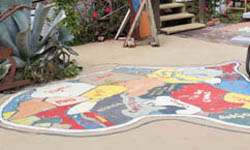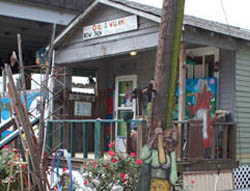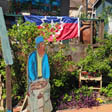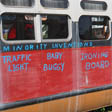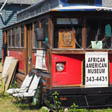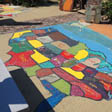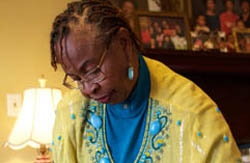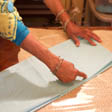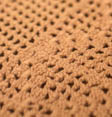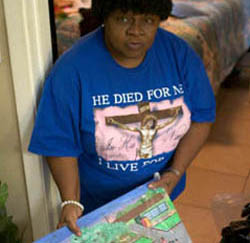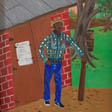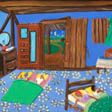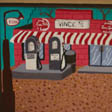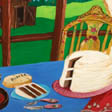The Power of Narrative: Tradition Bearers Share Inconvenient Truths
By Daniel Atkinson

Introduction
Loosely defined, narrative is a collection of related events, ideas, or patterns that form a story and/or identity. It is an essential component of what makes us human and it helps us to define who we are as individuals in the context of the world in which we live. In the United States, narrative plays a most powerful role in determining our values, morals, aesthetics, and status. While not the deciding factor, the narrative we assign to ourselves and others when coupled with an individual's character can often decide the kind of life that a person may lead and ultimately, their worldview. Therefore, a person born into a life of privilege and abundance is less likely to understand the struggles of someone who was born into a life of struggle, chaos, and inconsistency. This is particularly true if the chaos of the latter empowers the former, destroying the legitimacy of merit within the American narrative. The power lies in the fact that those of privilege explicitly or implicitly form the default to which everyone else is expected to aspire and accept, regardless of merit. This is further complicated by the insistence that the narrative of the less privileged is to be ignored, undervalued, and even erased if it is not readily available for conspicuous consumption. For example, the sovereignty that slavery and Jim Crow institutionally forced onto African Americans was, at the time, acceptable. However, that same sovereignty is unacceptable when asserted on a cultural level via protest, boycott, insistence of privacy and reciprocity, or simply a wish to self-seed culture without caveat as the basis for sovereignty. It's what Bobby Williams, an inmate at Angola State Penitentiary refers to as "Political H.I.V." Meaning, African Americans do not have an institutional immune system despite a guarantee of one in the constitution. This allows powerfully privileged people to treat the African American narrative as a salad bar where one can pick and choose what they like or what is most convenient for conspicuous consumption then, leave the rest to obscurity. Therein lies the fundamental hypocrisy of the standard American narrative. At the same time, that omission highlights the importance of people who choose to engage with the African American narrative beyond what is acceptable or convenient. It is a labor of love and in most cases a thankless way to demonstrate the wealth of our collective potential as Americans. Further, it is important to note that one does not have to be of African descent to recognize this, participate–or in the case of Allen Crochet–facilitate. All of the people in this essay have a unique experience of a lived life that informs their process and the recognition of that is as important to narrative as breath is to life itself.
If narrative plays such a powerful role in the worldview of a person, then the art as expressed by ANY individual can provide a wealth of contextual information about the attributes and shortcomings of the American social order, especially if they are among the disenfranchised or disinherited. On one hand, the vignettes in this essay are just like any other. On the other hand, they are unique in that they contain the inconvenient truth(s) that have always been present, but rarely included in the greater American narrative. This is vitally important because the status quo lends itself to the idea that difference in narrative often means deficient in value–and the effects can be catastrophic for those labeled as different. Nevertheless, it is through our differences that we can discover grounds for mutual understanding of narrative in a metacognitive sense. In other words, embracing the discomfort of the learning process is the only way for us to recognize our potential to fully give and receive love equally.
Sadie Roberts-Joseph, Founder/Curator, Odell S. Williams Now And Then African American Museum
As founder of the Odell S. Williams Now and Then African American Museum, Sadie Roberts-Joseph is very attuned to the contemporary American South and its denizens. She was born in rural Mississippi, but her family moved to North Louisiana and eventually settled in Baton Rouge where she still lives. Her childhood experiences read like a boilerplate narrative for most African Americans in the South:
Many of you will know that growing up back in the segregated South, you were not treated with the dignity and respect of other human beings. . . . I guess the kind of things that has given me the cushion and the buoyancy was knowing about who I was and whose I was and knowing that my life was as important as anyone else in that, that inner strength did not allow me to give in to what people say and how they treated you.
That inner strength, nurtured in the church has carried her throughout her life and compels her to foster that same kind of strength in the people around her, particularly children of all backgrounds.
A lifelong public servant, beginning in medicine and then in city government, Roberts-Joseph sees the work that she does at the museum as essential to promote the understanding that the American narrative needs to expand. That expansion is necessary to adapt and then embrace the histories of the disaffected, disinherited, and forgotten citizens of this country, particularly those who were emancipated in 1865, survived reconstruction, and whose descendants endured Jim Crow and integration. In 2001, she saw an opportunity to contribute to that calling via one of her fellow members at New St. Luke Baptist Church named Odell S. Williams (1922-2012). Williams was a retired schoolteacher who amassed a collection of photographs that cataloged the achievements of prominent African Americans as a way to supplement the education of the African American children she was teaching because that information was not included in the state-sanctioned curriculum. Ultimately, she was prevented from using the collection officially, so she felt compelled to hide it and employ it subversively. After her retirement, the collection was put on display in their church as part of the celebration of Black History Month. Seeing a need for year-round acknowledgement of an institutionalized erasure of the Black experience along with the resulting state of her neighborhood, she became inspired:
It was such rich history and I knew that it was very powerful because I could feel the power myself and others could also do the same I knew then that it was something that was worth perpetuating. It was something that was worth sacrificing my time and my energy and some of my resources to help create the same feeling, the same ambience into others who came in–to the children and the school system.
What started off as a display in the old sanctuary of her church has grown into a collection of art from the African diaspora and images of historical figures that fill the converted 1921 shotgun house that currently houses it all. The museum also hosts a retired city bus and trolley that serve as physical reminders of the civil rights struggle of the 20 th century. A recent visit from Dr. Lonnie Bunch, the founding director of the Smithsonian's National Museum of African American History and Culture is a great source of pride and helped to validate and empower her work. When asked for the ideal scenario for the museum going forward, she spoke of a state of the art facility that includes the original shotgun house the trolley, city bus, and the expanding collection of African and African American objects that she continues to collect. She later added that, "Any culture deserves to have it."
When I talked earlier about purpose, we all have a purpose and sometimes it takes a while to find that purpose. And as I matriculated, I guess from city government and medicine and all of that, I feel that I've finally come into my purpose, and that purpose is to teach African American history and culture to the City of Baton Rouge, the State of Louisiana and all of her visitors. And as we teach that, we will help to prepare the next generation of leaders and that is the thing that, you know, keeps me going because it's an important thing and you get a sense of satisfaction that help you to know that this is the right thing to do.
Sadie Roberts-Joseph feels a deep sense of duty to combat the growing swath of post-integration hopelessness that many Black children develop in Baton Rouge:
What we try to do is fill that emptiness with positivity. Give them something good to feel as sense of importance, a greater sense of self worth and to know that there are people who care about them. That went on and we saw the positivity action that the community working together can bring about. And that's what I want with this museum, is to create a positive difference, to give a positive sense of self-esteem.
That said, Roberts-Josephs was quick to mention that though the focus of the museum is history of African Americans, the story is applicable to anyone and everyone because ignorance does not discriminate and the more people who understand this narrative, the better. Only then can we combat what Langston Hughes referred to as "A dream deferred" in his poem, Harlem (1951).
Editor's Note, August 2019: Civil rights activist Sadie Roberts-Joseph passed away on July 12, 2019. The community response included services with testimonies to her role in the community and a spontaneous altar at the museum. Before her death, she renamed the museum The Baton Rouge African American Museum.
Diane Taylor: Quilting and Sewing
Diane Forrest Taylor is a former English teacher, published poet in the International Library of Poetry, advocate for the homeless and a sewing enthusiast. A naturally inquisitive person, Taylor embraces the creative process whole-heartedly and uses it in the service of others whenever possible. This all began when she learned to crochet at the age of seven or eight with pencils and later, a neighbor gave her a steel hook and thread along with instructional books to foster her development. Around that time she developed a creative process that continues to serve her well:
Sewing is nothing that you just can really plan to do. A seamstress is creating so she has to be in the mood to do it. If you force yourself to do it and you're not in that frame of mind, you won't do your best work. It's just like writing a poem. I don't pick up a pen or a paper until that poem has shaped in my head. Once I pick a pen and apply it to paper, the poem just flows line for line and when I put the pen down, it's done. That's the way I write.
She continued to say, "I reached a point in my life with my experiences, that I realized there was nothing I couldn't do, because everything I tried to do I was able to do. And, it was just such a natural thing to excel and my great aunt expected the best that we could give." That said, from the time she wakes until she sleeps, she is in motion nibbling at any number of creative projects.
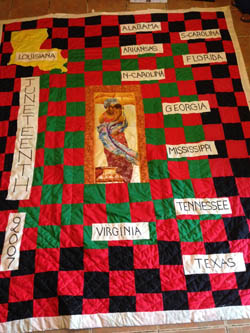
A project that Taylor is particularly proud of is a narrative quilt that was commissioned by Sadie Roberts-Joseph of the Odell S. Williams Now And Then African American Museum for Juneteenth in 2007. Along with celebrating the emancipation of enslaved people in the United States, the quilt was particularly instrumental in helping Taylor cope with the loss of her mother a year earlier. With a lot of help, the quilt was designed and delivered, complete with hand stitching in three and a half weeks! Fittingly, it features a mother and child in the center with a red, black, and green motif, reminiscent of Marcus Garvey's Universal Negro Improvement Association (UNIA) in 1920 who developed the color palate in order to help establish a sense of Black nationalism in the United States. Of vital importance in the quilt's acknowledgement of the prominent role that Louisiana played in the emancipation process, giving the "boot" to chattel slavery.
Along with several members of Shiloh Missionary Baptist Church in Baton Rouge, Taylor has taken on projects that advance her skills that allows her to serve other people:
The organizer of that group was a knitter and when I came aboard, I was the crochet expert. So what we do is a variety of activities that help us to improve our skills while we also do projects to help people. Our current project takes us away from knitting and crocheting. It's called Vanessa's Dresses for African Girls.
Vanessa's Dresses is named after a South African exchange student the church helped to sponsor for two years in Baton Rouge. Unfortunately, she passed away in South Africa at the age of seventeen and now they partner with another church to send small dresses made from pillowcases to Africa and Central America.
Jessie Coates: Primitive Painter
Jessie Coates is a primitive painter (an artist without formal training sometimes called an outsider artist) and makes images from the memories of her childhood in Port Hudson:
[There's] one [primitive artist] born every seventy-five years. There's seventy-five years between Grandma Moses and Clementine Hunter and there's seventy-five years between Clementine Hunter and myself. . . . It's a rare type of art. You're going to like the art or you're not going to like it. . . . I mean, I can go without painting for six or seven months and when I sit down it come[s] back to me. . . . I've been painting, I've been drawing since three years old, rather. Before I went to anybody's school, I knew how to draw. Not stick people, but actually draw. So I feel that my gift comes from, from God. . . . It's so much happened in my life during my childhood that I took for granted. . . . I went to art school for commercial art and I was discovered by my art instructor, that I was a primitive artist and I had to do research on primitive art and find out what it was and so, I started painting.
Art school nurtured her technique, but the subject matter comes strictly from her childhood and her need to document it before those who remember are no longer around to do so. Much of the value of her paintings lies in their expression of a uniquely African American perspective on life and beauty prior to integration. They are very simple and honest. In addition, they possess a cultural gravity that pulls the viewer in, provided they have an understanding of the subject matter, something that has been subverted at best and erased at worst in the greater American narrative. The kind of elegance expressed in Coates' painting is best understood by those who know the experience of Blackness in America and are willing to engage with it with honesty, candor, and a sense of humor. As she put it, "You can go to school, but they can't teach you how to . . . paint! I don't paint from pictures. I paint from memory." Like a gospel hymn, Jessie Coates' memories expressed through her artwork speak volumes about the shared Afro-American experience in ways that promote solidarity and uplift where there is little of either in abundance:
With my art you can see history, and to the younger, it's history, to them. And to the older people they can look at my artwork and reflect back on where God has brought them from.
One piece that illustrates this elegance is her piece, Too Hot to Sleep, that depicts a simple home with exposed timbers, a pallet bed, dry cell powered radio, and doors and windows open to allow airflow. To those in the know, it can conjure sounds, smells, and conversations that have long since left the scene except in memories of the Southern root of the African American narrative.
In 1992 Coates was featured in Country Home Magazine and traveled to Europe to show her paintings. And though Jessie Coates has not sold a painting in quite some time, she is still active. After all, it's her memory that drives her and not commissions. As she put it, "I won't stop painting. That's a part of me and there's so much to tell about life."



